
|
|
Abstract: A short scholarly article accompanied by numerous photographs of sacred Bahá'í sites in the Holy Land. Notes: The papers in this collection were delivered at the Seventh Annual Symposium of the Philip M. and Ethel Klutznick Chair in Jewish Civilization at Creighton University on October 2 and 3, 1994. |
Bahá'í Pilgrimage to Israel
by Gandhimohan Viswanathan
published in Pilgrims and Travelers to the Holy Land, pages 269-284Omaha: Creighton University Press, 1996
| Contents |
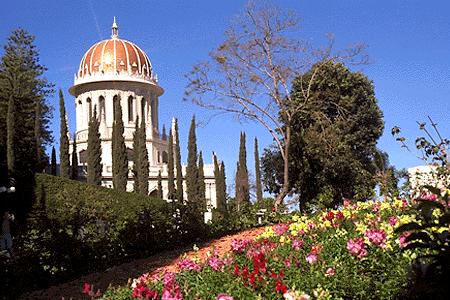 Flower garden near the Shrine of the Báb |
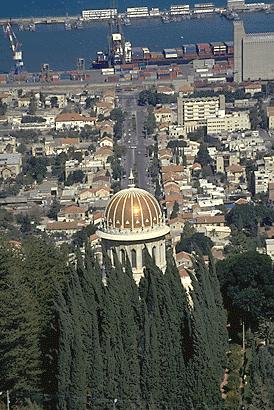 View of Haifa and harbor from above the Shrine of the Báb |
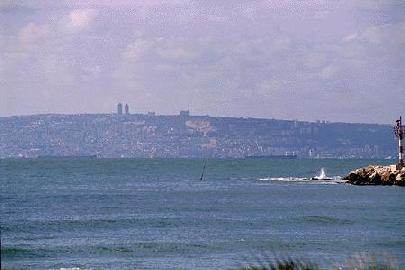 View of Haifa from `Akká, across the bay |
 Shrine of the Báb and new terrace |
 The wall of the Shrine of the Báb |
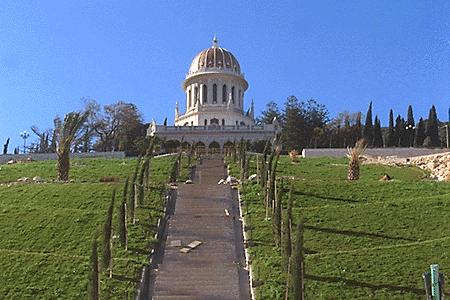 The steps leading up to the Shrine of the Báb |
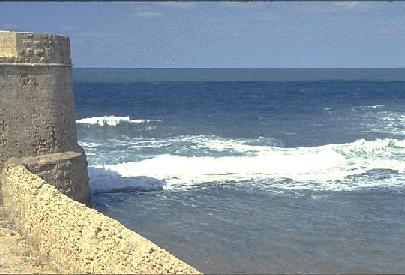 The sea wall at `Akká, near the Most Great Prison |
 The House of `Abbúd |
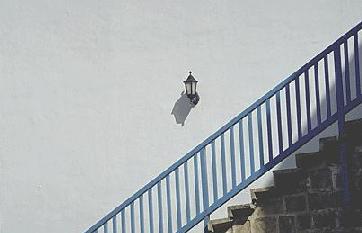 The House of `Abdu'lláh Páshá |
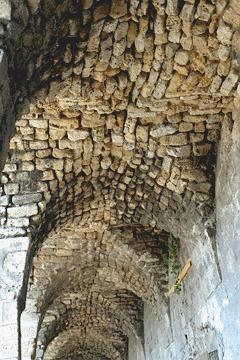 The Land Gate of `Akká |
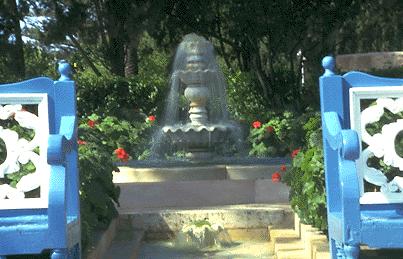 Fountain at Mazra`ih |
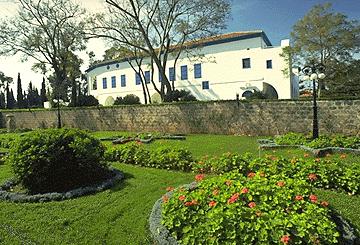 The Mansion of Bahjí |
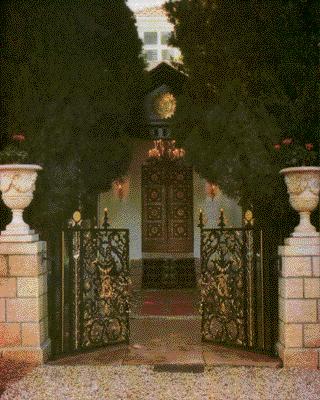 Entrance to the Shrine of Bahá'u'lláh |
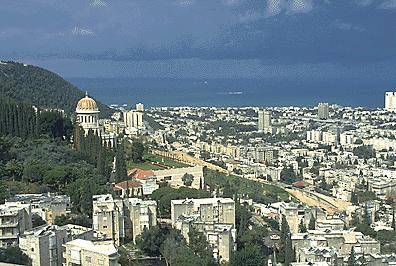 Haifa with the Shrine of the Báb |
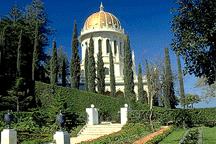 The Shrine of the Báb |
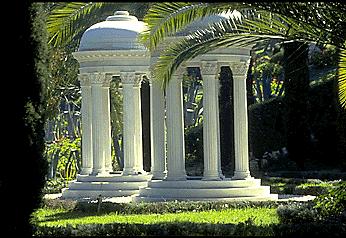 The Monument Gardens |
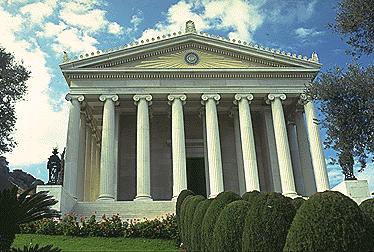 The International Archives building |
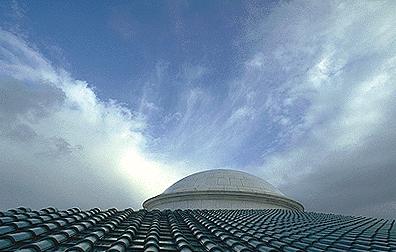 Roof of the Seat of the Universal House of Justice |
 Date palms lining the path by the Eastern Pilgrim House next to the Shrine of the Báb |
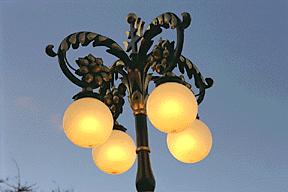 Lamp in garden near the Shrine of the Báb |
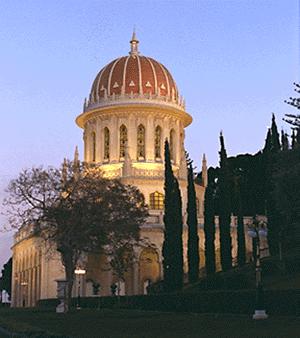 The Shrine of the Báb at dusk |
Abstract:
Bahá'í pilgrims have been converging at the Holy Land ever since Bahá'u'lláh (1817-1892), the founder of the Bahá'í Faith, was imprisoned in the fortress city of St. Jean d'Acre in 1868. This paper considers Bahá'í pilgrimage in a number of its aspects. The Holy Land's sacredness to the Bahá'í is shown to have a two-fold origin: Bahá'í belief in the oneness of religion and the divine origins of Judaism, Christianity, and Islam; and the Holy Land's association with the history of the Bahá'í Faith. Pilgrimage to the Bahá'í World Centre is presented as serving a collective function in the Bahá'í international community. The purpose of pilgrimage, the pilgrimage schedule, and some common practices associated with pilgrimage are discussed. It is noted that there no rituals associated with pilgrimage in the Bahá'í Faith. The origins, the scriptural basis, and the evolution over many decades of Bahá'í pilgrimage are examined. The two Bahá'í concepts of God and the Manifestation of God are introduced as pertinent to a proper understanding of the religious aspect of Bahá'í pilgrimage. It is argued that pilgrimage in the Bahá'í Faith is a subjective religious experience, and that pilgrimage is primarily not a material but a spiritual journey. It is proposed that the mystical purpose of pilgrimage is to evoke in the pilgrim a spiritual response. The major sites of the Bahá'í Faith in Israel are listed, and a brief treatment is given of the historical significance of the Bahá'í Holy Places in Haifa, Acre, and the surrounding area. The Bahá'í aesthetics of the sacred is explored. Three aesthetic characteristics of the Bahá'í Holy Places are discussed, especially as they relate to the two most important sites. It is concluded that pilgrimage to the Holy Land is one of the most holy Bahá'í observances and that pilgrims constitute the "life-blood" of the worldwide Bahá'í community.The Holy Land
The Holy Land is sacred to the Bahá'ís for two reasons: Bahá'í belief in the oneness of religion, and the Holy Land's association with the early history of the Bahá'í Faith. The combined effect of these two factors makes the Holy Land a very special place to the Bahá'ís.The Bahá'í Faith assumes a priori that religious revelation is not final but progressive, and that Judaism, Christianity, and Islam are all divine in origin.[01] Referring to the various world religions, Bahá'u'lláh (1817-1892), the prophet-founder of the Bahá'í Faith, wrote,
These principles and laws, these firmly-established and mighty systems, have proceeded from one Source, and are the rays of one Light. That they differ one from another is to be attributed to the varying requirements of the ages in which they were promulgated.[02]
The Holy Land of the Jews, Christians, and Muslims thus retains its significance and sacredness to the Bahá'ís. The Bahá'ís uphold the Torah, the New Testament, and the Quran as divinely inspired, and the fact that many of the historical figures mentioned in these great religious books actually lived and walked on the Holy Land is, by itself, sufficient reason for many Bahá'ís to revere the Holy Land. It has even been speculated that the Holy Land may bear some indirect relationship to other religions.[03]
But the Holy Land's significance to the Bahá'ís is not just a result of the Holy Land's association with previous religions. The Holy Land has a historical link to the Bahá'í Faith. The historical association is possibly the primary reason behind the great importance which Bahá'ís attach to the Holy Land.
Bahá'u'lláh's prophetic mission began in Persia in 1852 and he formally founded the Bahá'í Faith in 1863. He revealed many prayers, spiritual teachings, and social principles. Examples of his spiritual teachings include the oneness of God, the oneness of religion, and the oneness of mankind. Examples of his social teachings include universal education, world government, the abolishment of clergy, the abandonment of all forms of prejudice, the adoption of an auxiliary international language, and equal rights for men and women. Many of Bahá'u'lláh's ideas were too radical for the society in which he lived. The history of the persecution of the Bahá'í Faith dates back to the days of Bahá'u'lláh. From Persia he was exiled consecutively to Baghdad, to Constantinople, to Adrianople, and finally to the Holy Land.[04]
In 1868 Sultán `Abdu'-l`Azíz had Bahá'u'lláh sent to the fortress of St. Jean d'Acre (`Akká) in Ottoman Syria to live out the rest of his life there as a prisoner.[05] Bahá'u'lláh spent the last twenty-four years of his life in the vicinity of Haifa. Following Bahá'u'lláh's death in 1892, the reins of the Bahá'í Faith passed to his eldest son `Abdu'l-Bahá, and then to `Abdu'l-Bahá's grandson Shoghi Effendi, who was the Guardian of the Bahá'í Faith from 1921 to 1957. During these years both `Abdu'l-Bahá and Shoghi Effendi ministered to the needs of the Bahá'í international community from Haifa. The city continues today to be the administrative capital of the Bahá'í Faith. The Universal House of Justice, the supreme institution of the Bahá'í Faith, is situated on Mount Carmel in Haifa.[06]
Moreover, the spiritual capital of the Bahá'í Faith is also in the Holy Land. To the Bahá'í, the holiest spot on earth is the resting place of Bahá'u'lláh's mortal remains: the Shrine of Bahá'u'lláh at Bahjí, north of `Akká. Bahá'ís, when reciting their prayers, turn towards the Shrine of Bahá'u'lláh in the same way that Muslims turn to the Kaaba in Mecca. The Shrine of Bahá'u'lláh is the qiblih of the Bahá'í world.[07]
Evidence exists for the two-fold origin of the Holy Land's sacredness to Bahá'ís. The description of the Holy Land by Shoghi Effendi given below shows that the Holy Land's significance to the Bahá'ís has its origin both in Bahá'í belief in the divine origin of older religions, and in early Bahá'í history. Shoghi Effendi describes this region of the earth as
...the Holy Land-the Land promised by God to Abraham, sanctified by the Revelation of Moses, honoured by the lives and labours of the Hebrew patriarchs, judges, kings, and prophets, revered as the cradle of Christianity, and as the place where Zoroaster, according to `Abdu'l-Bahá's testimony, had "held converse with some of the prophets of Israel," and associated by Islám with the Apostle's night-journey, through the seven heavens, to the throne of the Almighty. Within the confines of this holy and enviable country, "the nest of all the prophets of God," "the Vale of God's unsearchable Decree, the snow-white Spot, the Land of unfading splendor" was the Exile of Baghdád, of Constantinople and Adrianople condemned to spend no less than a third of the allotted span of His life, and over half of the total period of His Mission. "It is difficult," declares `Abdu'l-Bahá, "to understand how Bahá'u'lláh could have been obliged to leave Persia, and to pitch His tent in this Holy Land, but for the persecution of His enemies, His banishment and exile."[08]
The Bahá'í pilgrim to the Holy Land is thus brought into contact with the sacred sites of four successive divine dispensations: Judaism, Christianity, Islam, and the Bahá'í Faith. As David Ruhe, former member of the Universal House of Justice, explains,
A pilgrimage to Israel constitutes a journey in progressive Revelation, an experience confirming the reality of the concept of evolution in religion.[09]
Bahá'í Pilgrimage
Pilgrimage serves an important function in the Bahá'í community. Bahá'ís rely upon faith in God, daily prayer, and meditative study of the sacred texts to effect the transformation of character necessary for personal growth and maturity. But the aim of the Bahá'í community is to create a world civilization that will in turn react upon the character of the individual. To Bahá'ís the concept of personal salvation is linked to collective salvation. Bahá'ís believe that "the world of humanity is a composite body" and that "when one part of the organism suffers all the rest of the body will feel its consequences." Guided by these principles, the Bahá'í community has accumulated over a century of experience in creating models of unity that transcend race, culture, nationality, class, and differences of sex and religion. Today over 2,100 ethnic groups and nationalities are represented in the worldwide Bahá'í community.[10] The heart of this global Bahá'í organism is the Bahá'í World Centre, and the flux of pilgrims to and from the Holy Land serves to maintain a sense of connectedness between the World Centre and the Bahá'í community at large. It is also a powerful force which inspires and revitalizes the Bahá'ís. The flow of pilgrims to the Holy Land has been compared to the life-blood of the Bahá'í community.[11]Pilgrimage is a privilege and an obligation in the Bahá'í Faith for those who can afford it. It is enjoined by Bahá'u'lláh in his most important work, the Kitáb-i-Aqdas (Most Holy Book), his Book of Laws.[12] There are three places to which pilgrimage is binding. The first of these is the former residence of the Báb (1819-1850), the prophet-founder of the Bábí religion, in Shiraz, Iran. The Báb was the forerunner of Bahá'u'lláh, and the Bábí and Bahá'í religions are intimately related.[13] The Báb's residence was demolished during the Islamic Revolution in Iran and has not yet been rebuilt. The second place of pilgrimage is the former residence of Bahá'u'lláh during his banishment and exile in Baghdad. Pilgrimages to Shiraz and Baghdad have been suspended due to conditions unfavorable to Bahá'ís in those lands. The third place of obligatory pilgrimage is the Shrine of Bahá'u'lláh at Bahjí.
The purpose of pilgrimage to the Holy Land is to pray at the Shrine of Bahá'u'lláh and, to a lesser extent, the Shrine of the Báb (see below). On the first day the pilgrims visit the Shrine of the Báb. From the second day onwards, the pilgrims visit the sites roughly in a descending order of spiritual significance, starting with the Shrine of Bahá'u'lláh. Although there is no ritual associated with Bahá'í pilgrimages, there are some practices which are quite common amongst the Bahá'ís. Circumambulation of the shrines and recitation of the Tablet of Visitation (see appendix) are two such practices.
Bahá'í pilgrimages began during the period of Bahá'u'lláh's banishment in Adrianople. Following the formal proclamation of his message to the Christian and Muslim rulers of the earth in 1867, Bahá'u'lláh asked one of the well-known Bahá'ís, Nabíl-i-A`zam, to go on pilgrimage.[14] Shoghi Effendi writes,
It was during those same days that Bahá'u'lláh instructed this same Nabíl to recite on His behalf the two newly revealed Tablets of the Pilgrimage, and to perform, in His stead, the rites prescribed in them, when visiting the Báb's House in Shíráz and the Most Great House in Baghdád -- an act that marks the inception of one of the holiest observances, which, in a later period, the Kitáb-i-Aqdas was to formally establish.[15]
Much change has taken place since the first pilgrims visited Bahá'u'lláh in prison in 1868. Pilgrimage then was a dangerous experience. By 1944, Shoghi Effendi was able to note,
we can even bear witness to the marked improvement in the conditions surrounding the pilgrimages performed by its devoted adherents to its consecrated shrines at its world center -- pilgrimages originally arduous, perilous, tediously long, often made on foot, at times ending in disappointment, and confined to a handful of harassed Oriental followers, gradually attracting, under steadily improving circumstances of security and comfort, an ever swelling number of new converts converging from the four corners of the globe, and culminating in the widely publicized yet sadly frustrated visit of a noble Queen [Marie of Rumania], who, at the very threshold of the city of her heart's desire, was compelled, according to her own written testimony, to divert her steps, and forego the privilege of so priceless a benefit.[16]
Today, Bahá'í pilgrimages can be arranged by contacting the appropriate department of the Bahá'í World Centre. Pilgrims converge in the Holy Land from all parts of the world. At present, pilgrimages last nine days. Special arrangements are made at the Bahá'í World Centre to provide local transportation to the Bahá'í properties and to ensure that the pilgrims receive guidance and explanations about the histories of the various sites. Every effort is made to enrich to the utmost these especially auspicious days in the lives of the Bahá'í pilgrims.
The future is expected to lead to a fuller and richer pilgrimage experience. Although pilgrimages to Iraq and Iran are at present impossible, the Bahá'ís are optimistic, and hope that one day the situation will change. The Bahá'í Faith is also growing very rapidly, and the number of pilgrims is very likely to increase in the near future. David Ruhe writes,
It is proper to expect that, with the spread of the Cause [sic] throughout the world and its increasing membership, the corresponding development of the [Bahá'í] World Centre will produce a great expansion of the pilgrimage experience. Just as the `flow of pilgrims ...constitutes the life-blood' of that Centre, so the World Centre itself, which is the spiritual heart, is growing larger and stronger as it beats the pulse of the new Bahá'í society.[17]
A Spiritual Journey
What is the significance of pilgrimage? If God is omnipresent, then why go to the Holy Land for pilgrimage? Why are holy places special if God transcends the physical universe? Since God created everything, how can some places be more holy than others? Is pilgrimage a physical act, or is it a spiritual journey?Bahá'í theology and theophanology very much influence and shape the Bahá'í pilgrimage experience. A discussion of Bahá'í pilgrimage which makes no reference to how Bahá'ís relate to God is ipso facto incomplete. God, Bahá'u'lláh says, is "sanctified above all attributes and holy above all names." [18] Humanity thus requires an intermediary, a prophet, to reveal the will of God. Bahá'ís use the term Manifestation of God to refer to these intermediaries.[19]
Every one of these Manifestations of God, Bahá'u'lláh says, has two stations: "the station of pure abstraction and essential unity," and "the station of distinction."[20][21] In the latter station, they are distinct servants of God. In the former station, they are all identically the Manifestation of God:
Were any of the all-embracing Manifestations of God to declare; "I am God," He, verily speaketh the truth, and no doubt attacheth thereto. For it hath been repeatedly demonstrated that through their Revelation, their attributes and names, the Revelation of God, His names and His attributes , are made manifest in the world....And were they all to proclaim , "I am the Seal of the Prophets,"they, verily, utter but the truth, beyond the faintest shadow of doubt. For they are all but one person, one soul, one spirit, one being, one revelation. They are all the manifestation of the "Beginning" and the "End," the "First" and the "Last," the "Seen" and the "Hidden" -- all of which pertain to Him Who is the Innermost Spirit of Spirits and Eternal Essence of Essences. And were they to say, "We are the Servants of God," this also is a manifest and indisputable fact. For they have been made manifest in the uttermost state of servitude, a servitude the like of which no man can possibly attain.[22]
Pilgrimage thus assumes a special significance for the Bahá'í. Pilgrimage to the abode of the Manifestation of God is almost like pilgrimage to the abode of God. To the Bahá'í, praying to the Manifestation of God is equivalent, in a sense, to praying to God. Obedience to the Manifestation of God is obedience to God. Bahá'ís thus have a very special place in their hearts for the great Manifestations of God. They love Bahá'u'lláh almost in the same way that they love God. This is why sites associated with Bahá'u'lláh are so special to Bahá'ís.
Variations in the way Bahá'ís relate to Bahá'u'lláh obviously lead to variations in the way in which Bahá'ís perceive the Holy Land and the Bahá'í Holy Places. The pilgrimage experience is subjective. Not only is each Bahá'í an individual who responds to God and religion in a unique way, but the absence of any clergy in the Bahá'í religion encourages the pilgrim to respond in an unfettered way to numinous stimuli. Each pilgrimage is bound to be different.
In view of the subjective nature of the pilgrimage experience, it may be of some benefit to the reader for this author to share his recollections of his pilgrimage. In July 1992 the author, then aged twenty-two, went on pilgrimage to the Holy Land. The Bahá'í community was then commemorating the one hundredth anniversary of Bahá'u'lláh's ascension, and 1992-3 was proclaimed a Bahá'í Holy Year. Going on pilgrimage during the Holy Year was an inestimable privilege in the eyes if this author, and I will never forget those blessed days of my life. In anticipation of my pilgrimage, I had memorized the Tablet of Visitation (see appendix) and was able to recite it by heart at the Shrine of the Báb and the Shrine of Bahá'u'lláh. I spent quite a bit of time there praying. I put a special effort not to ask God to fulfill my personal wishes, but instead I asked God to do with me as He pleased, and to allow me to live a life of service and sacrifice. Not only were those nine days in Israel some of the happiest in my entire life, but I believe that my character took a change for the better as a result of my pilgrimage. It was an eschatological event in my life, whose significance I am yet to understand in its full measure.
The mystical purpose of pilgrimage is to evoke in the individual a spiritual response. It is an opportunity for the individual to find new motivation in living a pure, holy life dedicated to God. `Abdu'l-Bahá explains,
Holy places are undoubtedly centres of the outpouring of Divine grace, because on entering the illumined sites associated with martyrs and holy souls, and by observing reverence, both physical and spiritual, one's heart is moved with great tenderness.[23]
Bahá'í Holy Places
Pilgrims visit a number of Bahá'í Holy Places in the Holy Land. The sites have a special significance to Bahá'ís because of the historical associations with the birth and development of the religion. Each site has its own history and to some Bahá'ís the relationship of the site to the historical figures of the Bahá'í Faith is as important as the site itself. David Ruhe writes,In the Haifa-`Akká area the Bahá'í Holy Places include a number of places large and small, developed or to be developed, which have been hallowed by the Dust of the Forerunner [the Báb] and by twenty-four years of Revelation of the Supreme Prophet [Bahá'u'lláh], have witnessed fifty-three years of devoted service and teaching by the Master, `Abdu'l-Bahá, and bear the imprint of a lifetime of selfless and indefatigable labour by the Guardian [Shoghi Effendi]. [24]
Below is a survey of the major sites of the Bahá'í Faith in the Holy Land. A discussion of the history behind each site is well beyond the scope of this work. The reader may wish to consult [07] and [30] for comprehensive treatments of the subject.
- Major sites of the Bahá'í Faith in the Holy Land:
- `Akká
- The `Akká Area
- Haifa
- Bahá'í Aesthetics of the Sacred
`Akká
The following are the major sites of `Akká (Acre):The Barracks
Bahá'u'lláh and his companions, the Bahá'í exiles, arrived in `Akká in the late afternoon of 31 August 1868. Shortly after arrival in the barracks, several Bahá'ís died and most fell sick due to the conditions in the prison. The isolation and pressures of imprisonment were compounded by mistreatment, by deliberate deprivations of food, and by an absence of hygiene. Bahá'u'lláh was imprisoned in the barracks for two years, two months, and five days.
The barracks was set upon the massive foundations of the great chapter fortress of the Crusader Knights of the Hospital and was built upon earlier buildings. The structure stood on the edge of the former inner moat and since garrison needs were limited, it could be used as a prison. It was known to some as `the Turkish Bastille'.
The Three Houses
Bahá'u'lláh was finally removed from the prison in 1870 to three successive houses within `Akká because the Turkish army required the barracks for its reorganization. Bahá'u'lláh was moved to the house of Malík, the house of Khavvám and the house of Rabí`ih. The length of his stay in these three houses was approximately ten months.
The House of `Abbúd
What is known as the House of `Abbúd is actually in two parts: the eastern part and the western part. The eastern part was known as the house of `Údí Khammár and western part as the house of `Abbúd.
Bahá'u'lláh was moved to the house of `Údí Khammár in 1871. It was so inadequate for the needs of the Bahá'ís that no less than thirteen persons of both sexes had to accommodate themselves in one of its rooms. The Kitáb-i-Aqdas, Bahá'u'lláh's Book of Laws and his most important work, was revealed in this house. `Abdu'l-Bahá got married in this house in 1872. Bahá'u'lláh lived in these two houses for a total of seven years.
Khán-i-`Avámíd
At the time of the transfer of Bahá'u'lláh and the Bahá'ís from the barracks to make room for the Turkish troops, most of Bahá'u'lláh's companions were consigned to a caravansarai named the Khán-i-`Avámíd (Inn of the Pillars). The means of comfort were so limited, and food was so scarce that each loaf of Arab bread, normally adequate for one meal for one person, had to be divided into four portions, for the four periods of the day! All other food was also strictly divided and assigned.
As the companions of Bahá'u'lláh took up residence in other houses, the Khán-i-`Avámíd became the first Bahá'í Pilgrim House of the Holy Land. Many eminent early Bahá'í believers stayed in and lived in this caravansarai.
The House of `Abdu'lláh Páshá
In 1896, four years after the death of Bahá'u'lláh, `Abdu'l-Bahá rented the house of `Abdu'lláh Páshá. The house of `Abbúd had become too small for the large family of Bahá'u'lláh. It was here that in March 1897, in an upper room of the south wing, the first child was born which was related both to Bahá'u'lláh and to his forerunner the Báb: Shoghi Effendi, Guardian of the Bahá'í Faith. Shoghi Effendi's mother was the eldest daughter of `Abdu'l-Bahá and his father was one of the relatives of the Báb. This house is also the site of the meeting between `Abdu'l-Bahá and the first pilgrim group from the West in the winter of 1898-9.
The Gates
The sea gate is the passage used by the Bahá'í exiles to enter the city. The land gate of `Akká witnessed passages of Bahá'u'lláh, `Abdu'l-Bahá, and Shoghi Effendi during their lifetimes.
The Cemeteries
North of the land gate is a small Muslim cemetery named after Nabí Sálih. Fourteen Bahá'ís were buried there, including one of the sons of Bahá'u'lláh who died in the barracks. The remains of Bahá'u'lláh's son were transferred to Mount Carmel in 1939.
East of the city, now within the area occupied by the Israel School for Naval Officers, lies an extensive Muslim cemetery which became after 1880 the burial place for the dead of the Bahá'í community. Several members of Bahá'u'lláh's family were buried here. Until the transfer of her remains to Mount Carmel, `Abdu'l-Bahá's mother was buried here.
The `Akká Area
The following sites are also in the Akka area:The Mansion of Mazra`ih
Nine years Bahá'u'lláh was confined within the city walls. His sole exercise had been to pace, in monotonous repetition, the floor of his own bed-chamber. `Abdu'l-Bahá relates that one day Bahá'u'lláh remarked,
I have not gazed on verdure for nine years. The country is the world of the soul, the city is the world of bodies.[25]
Realizing Bahá'u'lláh's longing for the country, `Abdu'l-Bahá decided to take him away from the city into the country. He was successful in renting a summer mansion of simple design located about four miles north of the city, and then informed Bahá'u'lláh that the "palace" was ready. "I am a prisoner," replied Bahá'u'lláh.[26] But at the insistence of the Muftí of `Akká, Bahá'u'lláh departed from the city for the Mansion of Mazra`ih. Bahá'u'lláh's liberation occurred in June 1877.
The Garden of Ridván
In 1875, expectant that Bahá'u'lláh would soon leave the city, `Abdu'l-Bahá rented some property, near a place called Shahuta, as a place of beauty and rest for Bahá'u'lláh. The garden of Na`mayn is a verdant knoll situated in the middle of a river east of `Akká. The garden became one of the favorite retreats of Bahá'u'lláh and was named Ridván (paradise) by him. There was also a simple house for the gardener or caretaker. That building is now known simply as the little house.
The Mansion of Bahjí
Bahá'u'lláh's two years at the Mansion of Mazra`ih were productive and pleasant. But the mansion was too small to serve the many needs of Bahá'u'lláh, his family , and the other exiles and expatriate settlers in `Akká. In 1879, Bahá'u'lláh moved to the Mansion of Bahjí.
`Údí Khammár, who had lavished much wealth on the construction of the mansion during the years of Bahá'u'lláh's incarceration in the barracks, had fled the mansion because of an outbreak of an epidemic disease. The Bahá'ís managed to rent, and later purchase the mansion without much difficulty. `Údí Khammár's commercial successes had enabled him to add extensively to the original structure built earlier in 1821. The mansion was surrounded by a garden and high wall, and the area around the mansion was known as al-Bahjá, Place of Delight. The following inscription in Arabic which `Údí Khammár had placed over the main doorway to welcome visitors is very thought-provoking to many Bahá'ís:
Greetings and salutations rest upon this Mansion which increaseth in splendour through the passage of time. Manifold wonders and marvels are found therein, and pens are baffled in attempting to describe them.[27]
The Shrine of Bahá'u'lláh
Bahá'u'lláh departed from this world on 29 May, 1892. The mortal remains are interred in the northernmost room of the mansion-complex of Bahjí, the Shrine of Bahá'u'lláh. It is the holiest place in the Bahá'í world.
Haifa
The following are the sites in Haifa.The Shrine of the Báb
Perhaps the most famous of all the Bahá'í monuments is the Shrine of the Báb, whose golden dome overlooks Ben-Gurion Avenue. The story of the many stages of its construction is very interesting. The Báb was publicly executed, in highly unusual circumstances, in Iran in 1850. His body was kept in concealment for many years, until Bahá'u'lláh, in 1891, expressed his wish to have the remains transferred to the Holy Land. Accordingly, `Abdu'l-Bahá made the necessary arrangements and the "Holy Dust" arrived secretly in `Akká by sea from Beirut on 31 January, 1899, and interred on Mount Carmel on 21 March, 1909. Through Shoghi Effendi's efforts, the Shrine of the Báb assumed its present enchanting appearance in 1953.
The House of the Master
`Abdu'l-Bahá left `Akká to move to Haifa in 1910. He designed the house and later constructed it. It is the house where Shoghi Effendi grew to maturity under the tutelage of `Abdu'l-Bahá. The house became `Abdu'l-Bahá's official residence.
The Shrine of `Abdu'l-Bahá
`Abdu'l-Bahá left this world on 28 November, 1921. His remains are temporarily interred in one of the nine rooms which make up the Shrine of the Báb.
The Monument Gardens
There are several other mausoleums on the Bahá'í properties on Mount Carmel. Those interred include Bahíyyih Khánum (`Abdu'l-Bahá's sister), Munírih Khánum (`Abdu'l-Bahá's spouse), Mírzá Mihdí (`Abdu'l-Bahá's brother, who died in the barracks), and Ásíyih Khánum (`Abdu'l-Bahá's mother).
The Temple Site
Near the time-honored cave of Elijah, at the head of Mount Carmel, is the site of the first Bahá'í House of Worship which will be built in the Holy Land. The property was purchased by Shoghi Effendi. An obelisk stands at the site today, in recognition of the fact that the construction of the temple is many decades away.
The Buildings of the Arc
Since the days of Shoghi Effendi, the Bahá'í world has been engaged in the construction of the five buildings of the Arc on Mount Carmel, Haifa. Together the five buildings stand along an arc or semicircle, and are made up of nearly symmetrical structures on either side of the central building. The two outer buildings are the International Archives and the International Library. The two inner buildings are the Centre for the Study of the Sacred Texts and the International Teaching Centre. The central building is the Universal House of Justice.
These buildings will together be the seat of the Bahá'í administrative system, which is still in its embryonic stage at this time. Bahá'ís believe that one day these institutions will constitute a form of world government which will guarantee that human progress will be directed towards the goal of an ever-advancing civilization. Quoting Shoghi Effendi, the Universal House of Justice announced in 1975 that the process of building the Arc on Mount Carmel "will synchronize with two no less significant developments-the establishment of the Lesser Peace and the evolution of Bahá'í national and local institutions."[28] The Lesser Peace is the term used by Bahá'u'lláh to refer to that global political peace which must be firmly established before the coming of the Most Great Peace, awaited by the saints, seers, and poets of ages past. Bahá'ís are expectant that the Lesser Peace will come before the end the of this century.
Bahá'í Aesthetics of the Sacred
It has been suggested by Robert Stockman, Coordinator of the Research Office of the Bahá'í National Center in Wilmette, Illinois, that Bahá'í Holy Places have three characteristics: light, greenery, and the presence of objets d'art.[29] In many of his writings, Bahá'u'lláh uses light as a metaphor to indicate spiritual illumination. Greenery and gardens are suggestive of spiritual life. Gardens are also reminiscent of Eden. Works of art are pleasing to the eye and serve to beautify the sites.The Shrine of Bahá'u'lláh and the Shrine of the Báb are well illuminated by lamps and windows, and are surrounded by gardens. There are trees in the interior of the Shrine of Bahá'u'lláh. This is very different from the aesthetics of medieval cathedrals, for example. It has been suggested that the gardens almost form an integral part of the Bahá'í shrines.[30] In this respect, the Bahá'í gardens in the Holy Land are possibly unique among religious sites. The interior of the Shrine of the Báb is decorated with Persian carpets, menorahs, and illuminated texts from Bahá'í scripture. Examples of objets d'art found in other sites include Chinese art, and statuary.
Conclusion
Pilgrimage to the Holy Land is one of the holiest Bahá'í observances set down by Bahá'u'lláh in his Book of Laws, the Kitáb-i-Aqdas. Pilgrims from all over the world converge at the Bahá'í World Centre. They come from many nations, diverse religious backgrounds, various races, and differing social strata. Their purpose in coming to the Holy Land is to visit and pray at the Bahá'í shrines. Although visits to the holy sites of Judaism, Christianity, and Islam are not part of Bahá'í pilgrimages, many Bahá'ís visit these sites before or after their Bahá'í pilgrimages. They return home with greater zeal to impart to their friends some of their newfound admiration and love. Pilgrims are the "life-blood" of the worldwide Bahá'í community.
Tablet of Visitation
(This Tablet is read at the Shrines of Bahá'u'lláh and the Báb. It is also frequently used in commemorating Their anniversaries.)
The praise which hath dawned from Thy most august Self, and the glory which hath shone forth from Thy most effulgent Beauty, rest upon Thee, O Thou Who art the Manifestation of Grandeur, and the King of Eternity, and the Lord of all who are in heaven and on earth! I testify that through Thee the sovereignty of God and His dominion, and the majesty of God and His grandeur, were revealed, and the Daystars of ancient splendor have shed their radiance in the heaven of Thine irrevocable decree, and the Beauty of the Unseen hath shone forth above the horizon of creation. I testify, moreover, that with but a movement of Thy Pen Thine injuction "Be Thou" hath been enforced, and God's hidden Secret hath been divulged, and all created things have been called into being, and all the Revelations have been sent down.I bear witness, moreover, that through Thy beauty the beauty of the Adored One hath been unveiled, and through Thy face the face of the Desired One hath shone forth, and that through a word from Thee Thou hast decided between all created things, caused them who are devoted to Thee to ascend unto the summit of glory, and the infidels to fall into the lowest abyss.
I bear witness that he who hath known Thee hath known God, and he who hath attained unto Thy presence hath attained unto the presence of God. Great, therefore, is the blessedness of him who hath believed in Thee, and in Thy signs, and hath humbled himself before Thy sovereignty, and hath been honored with meeting Thee, and hath attained the good pleasure of Thy will, and circled around Thee, and stood before Thy throne. Woe betide him that hath transgressed against Thee, and hath denied Thee, and repudiated Thy signs, and gainsaid Thy sovereignty, and risen up against Thee, and waxed proud before Thy face, and hath disputed Thy testimonies, and fled from Thy rule and Thy dominion, and been numbered with the infidels whose names have been inscribed by the fingers of Thy behest upon Thy holy Tablets.
Waft, then, unto me, O my God and my Beloved, from the right hand of Thy mercy and Thy loving-kindness, the holy breaths of Thy favors, that they may draw me away from myself and from the world unto the courts of Thy nearness and Thy presence. Potent art Thou to do what pleaseth Thee. Thou, truly, hast been supreme over all things.
The remembrance of God and His praise, and the glory of God and His splendor, rest upon Thee, O Thou Who art His Beauty! I bear witness that the eye of creation hath never gazed upon one wronged like Thee. Thou wast immersed all the days of Thy life beneath an ocean of tribulations. At one time Thou wast in chains and fetters; at another Thou wast threatened by the sword of Thine enemies. Yet despite all this, Thou didst enjoin upon all men to observe what had been prescribed unto Thee by Him Who is the All-Knowing, the All-Wise.
May my spirit be a sacrifice to the wrongs Thou didst suffer, and my soul be a ransom for the adversities Thou didst sustain. I beseech God, by Thee and by them whose faces have been illumined with the splendors of the light of Thy countenance, and who, for love of Thee, have observed all whereunto they were bidden, to remove the veils that have come in between Thee and Thy creatures, and to supply me with the good of this world and the world to come. Thou art, in truth, the Almighty, the Most Exalted, the All-Glorious, the Ever-Forgiving, the Most Compassionate.
Bless Thou, O Lord my Lord, the Divine Lote-Tree and its leaves, and its boughs, and its branches, and its stems, and its offshoots, as long as Thy most excellent titles will endure and Thy most august attributes will last. Protect it, then, from the mischief of the aggressor and the hosts of tyranny. Thou art, in truth, the Almighty, the Most Powerful. Bless Thou, also, O Lord my God, Thy servants and Thy handmaidens who have attained unto Thee, Thou, truly, art the All-Bountiful, Whose grace is infinite. No God is there save Thee, the Ever-Forgiving, the Most Generous. - Bahá'u'lláh
Footnotes
01. For a textbook introduction to the Bahá'í Faith see J.E. Esslemont, Bahá'u'lláh and the New Era. Wilmette, IL: Bahá'í Publishing Trust, 1970.
02. Gleanings from the Writings of Bahá'u'lláh. Trans. Shoghi Effendi. (Wilmette: Bahá'í Publishing Trust, 1976.), 287-8.
03. Jamshed Fozdar, who has studied Buddhism and Hinduism extensively, has speculated that the Pure Land of the West mentioned by the Buddha refers to the Holy Land. `Abdu'l-Bahá has stated that Zoroaster "held converse" with some of the prophets of Israel in the Holy Land.
04. For convenience, the Bahá'í system of transliteration is used for Persian and Arabic words. Most of the literature on the Bahá'í Faith is written using this convention.
05. Shoghi Effendi, God Passes By. (Wilmette:Bahá'í Publishing Committee, 1944), 179-196.
06. Peter Smith, The Bahá'í and Bábí Religions. (Cambridge: Cambridge University Press, 1987), 131-138, 162.
07. David S. Ruhe, The Door of Hope. (Oxford: George Ronald, 1983),112.
10. The Vision of Race Unity: America's Most Challenging Issue. Wilmette: Bahá'í Publishing Trust, 1991.
11. Shoghi Effendi,The Advent of Divine Justice. (Wilmette: Bahá'í Publishing Trust, 1963), 4.
12. Bahá'u'lláh,The Kitáb-i-Aqdas: The Most Holy Book. (Wilmette: Bahá'í Publishing Trust, 1993), 31.
14. Bahá'u'lláh sent letters to the rulers of his time proclaiming his mission. See Esslemont.
18. See the Bahá'í Long Obligatory Prayer. Bahá'u'lláh commands the Bahá'ís to pray at least daily. The Bahá'ís are free to chose one of the three prayers specifically revealed for this purpose. The Long Obligatory Prayer is the longest of the three. For the text of the prayer, see Aqdas, 93-9.
19. The Manifestations of God include, but are not limited to, Moses, Krishna, Zoroaster, Buddha, Christ, Muhammad, the Báb, and Bahá'u'lláh. Bahá'ís do not believe in the finality of Bahá'u'lláh's revelation, and expect another Manifestation of God to appear after the elapse of one thousand years. The identities of the Manifestations of God who lived prior to the onset of recorded history, Bahá'u'lláh has stated, may have been lost due to the passage of time.
21. For Bahá'u'lláh's most important work about God, religion, and scripture, see the Kitáb-i-Íqán: The Book of Certitude, trans. Shoghi Effendi (London: Bahá'í Publishing Trust, 1946). The Kitáb-i-Íqán is Bahá'u'lláh's second most important work after the Book of Laws.
23. Synopsis and Codification of the Laws and Ordinances of the Kitáb-i-Aqdas. (Haifa: Bahá'í World Centre, 1973), 61
28. From a letter to the Bahá'í world dated June 5, 1975.
29. Robert Stockman. Interview with author. Boston, April 11, 1994.
30. Bahá'í Holy Places at the World Centre. Haifa: Bahá'í World Centre, 1968.
|
|